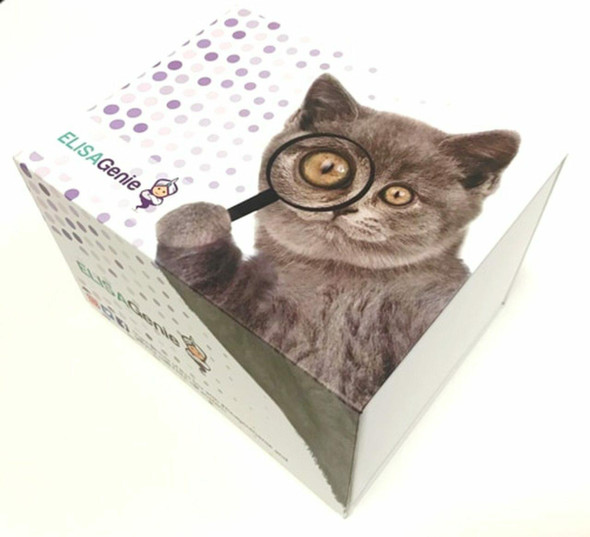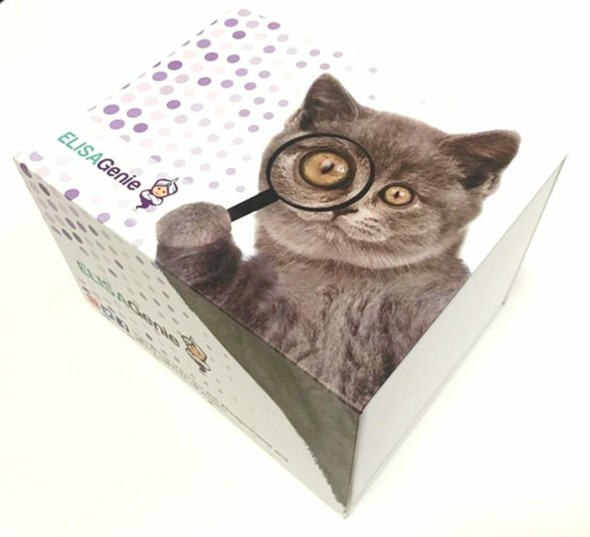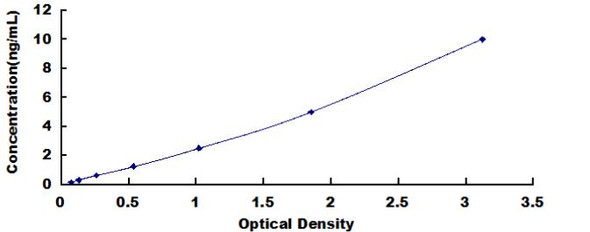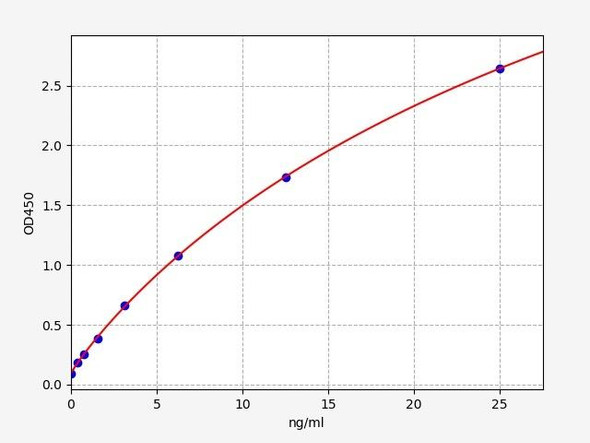Human C-jun (V-Jun Sarcoma Virus 17 Oncogene Homolog) ELISA Kit (HUES01888)
- SKU:
- HUES01888
- Product Type:
- ELISA Kit
- Size:
- 96 Assays
- Uniprot:
- P05412
- Sensitivity:
- 0.47ng/mL
- Range:
- 0.78-50ng/mL
- ELISA Type:
- Sandwich
- Reactivity:
- Human
- Sample Type:
- Serum, plasma and other biological fluids
- Research Area:
- Epigenetics and Nuclear Signaling
Description
Human C-jun (V-Jun Sarcoma Virus 17 Oncogene Homolog) ELISA Kit
The Human C-Jun (V-Jun Sarcoma Virus 17 Oncogene Homolog) ELISA Kit is specifically designed for the precise and sensitive detection of C-Jun levels in human serum, plasma, and cell culture supernatants. This kit offers high reliability and reproducibility, making it perfect for a variety of research purposes.C-Jun is a key regulatory protein that plays a crucial role in cellular processes such as cell growth, differentiation, and apoptosis. Dysregulation of C-Jun has been linked to various diseases, including cancer, inflammation, and neurodegenerative disorders.
Therefore, studying C-Jun levels can provide valuable insights into the pathogenesis of these conditions and aid in the development of targeted therapies.With its high sensitivity and specificity, the Human C-Jun ELISA Kit from Assay Genie is a valuable tool for researchers and clinicians looking to explore the role of C-Jun in disease progression and treatment. Trust in the accuracy and precision of this ELISA kit to advance your research in the field of oncology and beyond.
| Assay type: | Sandwich |
| Format: | 96T |
| Assay time: | 4.5h |
| Reactivity: | Human |
| Detection Method: | Colormetric |
| Detection Range: | 0.78-50 ng/mL |
| Sensitivity: | 0.47 ng/mL |
| Sample Volume Required Per Well: | 100µL |
| Sample Type: | Serum, plasma and other biological fluids |
| Specificity: | This kit recognizes Human C-jun in samples. No significant cross-reactivity or interference between Human C-jun and analogues was observed. |
This ELISA kit uses Sandwich-ELISA as the method. The micro ELISA plate provided in this kit has been pre-coated with an antibody specific to Human C-jun. Standards or samples are added to the appropriate micro ELISA plate wells and combined with the specific antibody. Then a biotinylated detection antibody specific for Human C-jun and Avidin-Horseradish Peroxidase (HRP) conjugate are added to each micro plate well successively and incubated. Free components are washed away. The substrate solution is added to each well. Only those wells that contain Human C-jun, biotinylated detection antibody and Avidin-HRP conjugate will appear blue in color. The enzyme-substrate reaction is terminated by adding Stop Solution and the color turns yellow. The optical density (OD) is measured spectrophotometrically at a wavelength of 450 nm ± 2 nm. The OD value is proportional to the concentration of Human C-jun. The concentration of Human C-jun in samples can be calculated by comparing the OD of the samples to the standard curve.
| UniProt Protein Function: | Transcription factor that recognizes and binds to the enhancer heptamer motif 5'-TGA[CG]TCA-3'. Promotes activity of NR5A1 when phosphorylated by HIPK3 leading to increased steroidogenic gene expression upon cAMP signaling pathway stimulation. Involved in activated KRAS-mediated transcriptional activation of USP28 in colorectal cancer (CRC) cells (PubMed:24623306). Binds to the USP28 promoter in colorectal cancer (CRC) cells (PubMed:24623306). |
| NCBI Summary: | This gene is the putative transforming gene of avian sarcoma virus 17. It encodes a protein which is highly similar to the viral protein, and which interacts directly with specific target DNA sequences to regulate gene expression. This gene is intronless and is mapped to 1p32-p31, a chromosomal region involved in both translocations and deletions in human malignancies. [provided by RefSeq, Jul 2008] |
| UniProt Code: | P05412 |
| NCBI GenInfo Identifier: | 135298 |
| NCBI Gene ID: | 3725 |
| NCBI Accession: | P05412. 2 |
| UniProt Secondary Accession: | P05412,Q6FHM7, Q96G93, |
| UniProt Related Accession: | P05412 |
| Molecular Weight: | |
| NCBI Full Name: | Transcription factor AP-1 |
| NCBI Synonym Full Names: | jun proto-oncogene |
| NCBI Official Symbol: | JUN |
| NCBI Official Synonym Symbols: | AP1; AP-1; c-Jun |
| NCBI Protein Information: | transcription factor AP-1 |
| UniProt Protein Name: | Transcription factor AP-1 |
| UniProt Synonym Protein Names: | Activator protein 1; AP1; Proto-oncogene c-Jun; V-jun avian sarcoma virus 17 oncogene homolog; p39 |
| Protein Family: | C-Jun-amino-terminal kinase-interacting protein |
| UniProt Gene Name: | JUN |
| UniProt Entry Name: | JUN_HUMAN |
As the OD values of the standard curve may vary according to the conditions of the actual assay performance (e. g. operator, pipetting technique, washing technique or temperature effects), the operator should establish a standard curve for each test. Typical standard curve and data is provided below for reference only.
| Concentration (ng/mL) | O.D | Average | Corrected |
| 50 | 2.357 2.415 | 2.386 | 2.304 |
| 25 | 1.555 1.603 | 1.579 | 1.497 |
| 12.5 | 0.919 0.903 | 0.911 | 0.829 |
| 6.25 | 0.412 0.432 | 0.422 | 0.34 |
| 3.13 | 0.258 0.256 | 0.257 | 0.175 |
| 1.57 | 0.188 0.17 | 0.179 | 0.097 |
| 0.78 | 0.127 0.137 | 0.132 | 0.05 |
| 0 | 0.079 0.085 | 0.082 | -- |
Precision
Intra-assay Precision (Precision within an assay): 3 samples with low, mid range and high level Human C-jun were tested 20 times on one plate, respectively.
Inter-assay Precision (Precision between assays): 3 samples with low, mid range and high level Human C-jun were tested on 3 different plates, 20 replicates in each plate.
| Intra-assay Precision | Inter-assay Precision | |||||
| Sample | 1 | 2 | 3 | 1 | 2 | 3 |
| n | 20 | 20 | 20 | 20 | 20 | 20 |
| Mean (ng/mL) | 2.68 | 4.86 | 17.60 | 2.72 | 4.91 | 17.90 |
| Standard deviation | 0.18 | 0.24 | 0.77 | 0.19 | 0.25 | 0.82 |
| C V (%) | 6.72 | 4.94 | 4.38 | 6.99 | 5.09 | 4.58 |
Recovery
The recovery of Human C-jun spiked at three different levels in samples throughout the range of the assay was evaluated in various matrices.
| Sample Type | Range (%) | Average Recovery (%) |
| Serum (n=5) | 94-109 | 101 |
| EDTA plasma (n=5) | 87-99 | 93 |
| Cell culture media (n=5) | 91-102 | 96 |
Linearity
Samples were spiked with high concentrations of Human C-jun and diluted with Reference Standard & Sample Diluent to produce samples with values within the range of the assay.
| Serum (n=5) | EDTA plasma (n=5) | Cell culture media (n=5) | ||
| 1:2 | Range (%) | 87-99 | 93-107 | 95-110 |
| Average (%) | 92 | 101 | 101 | |
| 1:4 | Range (%) | 92-105 | 82-93 | 86-97 |
| Average (%) | 99 | 88 | 92 | |
| 1:8 | Range (%) | 88-103 | 83-95 | 83-97 |
| Average (%) | 94 | 89 | 89 | |
| 1:16 | Range (%) | 87-103 | 82-94 | 82-95 |
| Average (%) | 94 | 89 | 88 |
An unopened kit can be stored at 4°C for 1 month. If the kit is not used within 1 month, store the items separately according to the following conditions once the kit is received.
| Item | Specifications | Storage |
| Micro ELISA Plate(Dismountable) | 8 wells ×12 strips | -20°C, 6 months |
| Reference Standard | 2 vials | |
| Concentrated Biotinylated Detection Ab (100×) | 1 vial, 120 µL | |
| Concentrated HRP Conjugate (100×) | 1 vial, 120 µL | -20°C(shading light), 6 months |
| Reference Standard & Sample Diluent | 1 vial, 20 mL | 4°C, 6 months |
| Biotinylated Detection Ab Diluent | 1 vial, 14 mL | |
| HRP Conjugate Diluent | 1 vial, 14 mL | |
| Concentrated Wash Buffer (25×) | 1 vial, 30 mL | |
| Substrate Reagent | 1 vial, 10 mL | 4°C(shading light) |
| Stop Solution | 1 vial, 10 mL | 4°C |
| Plate Sealer | 5 pieces | |
| Product Description | 1 copy | |
| Certificate of Analysis | 1 copy |
- Set standard, test sample and control (zero) wells on the pre-coated plate and record theirpositions. It is recommended to measure each standard and sample in duplicate. Note: addall solutions to the bottom of the plate wells while avoiding contact with the well walls. Ensuresolutions do not foam when adding to the wells.
- Aliquot 100 µL of standard solutions into the standard wells.
- Add 100 µL of Sample / Standard dilution buffer into the control (zero) well.
- Add 100 µL of properly diluted sample (serum, plasma, tissue homogenates and otherbiological fluids) into test sample wells.
- Cover the plate with the sealer provided in the kit and incubate for 90 min at 37 °C.
- Aspirate the liquid from each well, do not wash. Immediately add 100 µL of BiotinylatedDetection Ab working solution to each well. Cover the plate with a plate seal and gently mix. Incubate for 1 hour at 37 °C.
- Aspirate or decant the solution from the plate and add 350 µL of wash buffer to each welland incubate for 1-2 minutes at room temperature. Aspirate the solution from each well andclap the plate on absorbent filter paper to dry. Repeat this process 3 times. Note: a microplatewasher can be used in this step and other wash steps.
- Add 100 µL of HRP Conjugate working solution to each well. Cover with a plate seal andincubate for 30 min at 37 °C.
- Aspirate or decant the solution from each well. Repeat the wash process for five times asconducted in step 7.
- Add 90 µL of Substrate Reagent to each well. Cover with a new plate seal and incubate forapproximately 15 min at 37 °C. Protect the plate from light. Note: the reaction time can beshortened or extended according to the actual color change, but not by more than 30min.
- Add 50 µL of Stop Solution to each well. Note: Adding the stop solution should be done inthe same order as the substrate solution.
- Determine the optical density (OD value) of each well immediately with a microplate readerset at 450 nm.









